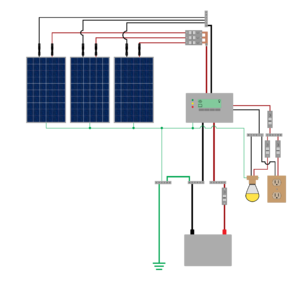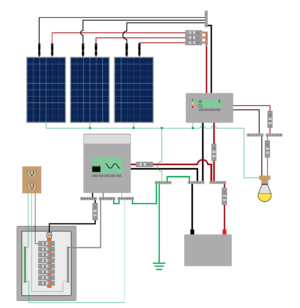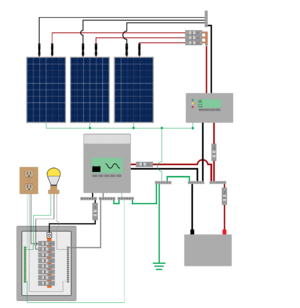Difference between revisions of "Stand-alone system configurations"
| (3 intermediate revisions by the same user not shown) | |||
| Line 1: | Line 1: | ||
[[Category:Detailed system design basics]] | [[Category:Detailed system design basics]] | ||
| − | [[File:DConlysystem.png|thumb| | + | <languages /> |
| + | <translate> | ||
| + | <!--T:1--> | ||
| + | [[File:DConlysystem.png|thumb|A three-line wiring diagram of a DC-only stand-alone PV system with a charge controller with DC lighting control for lighting and small DC loads.]] | ||
| + | |||
| + | <!--T:2--> | ||
There are many different possible designs and configurations for stand-alone off-grid PV systems. The focus of this design project is on small-scale systems, which will serve to constrain the number of designs that will be explored here. It is worth noting that the number of possible designs increases greatly as system size and complexity increases. Small-scale stand-alone systems can be divided into three main categories based upon the loads that are intended to power: DC only, AC and DC, and AC only. The most appropriate out of these designs will be determined by the energy needs and particular loads of the project. | There are many different possible designs and configurations for stand-alone off-grid PV systems. The focus of this design project is on small-scale systems, which will serve to constrain the number of designs that will be explored here. It is worth noting that the number of possible designs increases greatly as system size and complexity increases. Small-scale stand-alone systems can be divided into three main categories based upon the loads that are intended to power: DC only, AC and DC, and AC only. The most appropriate out of these designs will be determined by the energy needs and particular loads of the project. | ||
| + | <!--T:3--> | ||
The three-line wiring diagrams presented below and in the rest of this design process omit certain components as they are not installed with all systems and adding them would add additional complexity to the wiring diagram. The following components should be considered for incorporation into any off-grid system: | The three-line wiring diagrams presented below and in the rest of this design process omit certain components as they are not installed with all systems and adding them would add additional complexity to the wiring diagram. The following components should be considered for incorporation into any off-grid system: | ||
| − | |||
| − | |||
| − | |||
| − | |||
| − | |||
| − | |||
| − | ==DC only system== | + | <!--T:4--> |
| − | [[File:ACDCsystem.png|thumb| | + | *[[Special:MyLanguage/Ground fault protection device|Ground fault protection device (GFPD)]] |
| − | An ideal system for | + | |
| + | <!--T:5--> | ||
| + | *[[Special:MyLanguage/Residual current device|Residual current device (RCD) or ground fault current interrupter (GFCI)]] | ||
| + | |||
| + | <!--T:6--> | ||
| + | *[[Special:MyLanguage/Shunt|Shunt]] | ||
| + | |||
| + | <!--T:7--> | ||
| + | *[[Special:MyLanguage/Charge controller#Temperature sensor|Charge controller temperature sensor]] | ||
| + | |||
| + | <!--T:8--> | ||
| + | *[[Special:MyLanguage/Low voltage disconnect|Low voltage disconnect]] | ||
| + | |||
| + | <!--T:9--> | ||
| + | *[[Special:MyLanguage/DC-DC converter|DC-DC converter]] | ||
| + | |||
| + | ==DC only system== <!--T:10--> | ||
| + | |||
| + | <!--T:11--> | ||
| + | [[File:ACDCsystem.png|thumb|A three-line wiring diagram of a stand-alone AC/DC PV system with a charge controller with DC lighting control for DC lighting and DC loads and an inverter for AC loads.]] | ||
| + | |||
| + | <!--T:12--> | ||
| + | An ideal system for applications that have limited load requirements like [[Special:MyLanguage/Lighting|lighting]], cell phone charging, a radio, [[Special:MyLanguage/Energy efficient loads|an energy efficient DC TV]], and [[Special:MyLanguage/Energy efficient loads|an energy efficient DC fan]]. DC appliances do not suffer from the efficiency losses of an [[Special:MyLanguage/Inverter|inverter]], the standby consumption of an inverter, nor from downtime resulting from an inverter failure. | ||
| + | <!--T:13--> | ||
Considerations: | Considerations: | ||
| + | |||
| + | <!--T:14--> | ||
*Safe for users, very low likelihood of an accident occurring. | *Safe for users, very low likelihood of an accident occurring. | ||
| + | |||
| + | <!--T:15--> | ||
*Low cost. | *Low cost. | ||
| − | |||
| − | |||
| − | |||
| − | ==AC/DC system== | + | <!--T:16--> |
| − | [[File:AConlysystem.png|thumb| | + | *A DC system voltage of 12 V is typical for these systems in order to ensure compatibility with DC appliances, although a [[Special:MyLanguage/DC-DC converter|DC-DC converter]] is an option for larger 24V or 48V designs in order to ensure compatibility with 12 V appliances. DC appliances are not common in many areas of the world and may also be higher in price - this must be considered when designing a system. |
| + | |||
| + | <!--T:17--> | ||
| + | *If the current requirement of the loads exceeds the lighting/load output of the charge controller, then a separate connection to the battery with a [[Special:MyLanguage/Low voltage disconnect|low voltage disconnect]] should be made. | ||
| + | |||
| + | <!--T:18--> | ||
| + | *The low operating voltage of 12 V DC systems can make them susceptible to [[Special:MyLanguage/Voltage drop|voltage drop]] problems with long circuit runs for lighting/loads. | ||
| + | |||
| + | ==AC/DC system== <!--T:19--> | ||
| + | |||
| + | <!--T:20--> | ||
| + | [[File:AConlysystem.png|thumb|A three-line wiring diagram of a stand-alone AC-only PV system with a charge controller with an inverter that supplies power to both lighting and loads.]] | ||
| + | |||
| + | <!--T:21--> | ||
A system that incorporates an inverter to create a more flexible system that can power both DC and AC loads. Retaining DC lighting allows the user to turn off the inverter when not in use in order to avoid standby consumption losses and to still have light in the event of an inverter failure. | A system that incorporates an inverter to create a more flexible system that can power both DC and AC loads. Retaining DC lighting allows the user to turn off the inverter when not in use in order to avoid standby consumption losses and to still have light in the event of an inverter failure. | ||
| + | <!--T:22--> | ||
Considerations: | Considerations: | ||
| + | |||
| + | <!--T:23--> | ||
*Less safe for users than a DC only system, higher likelihood of an accident occurring due to the higher voltage of AC circuits. | *Less safe for users than a DC only system, higher likelihood of an accident occurring due to the higher voltage of AC circuits. | ||
*Additional cost of an inverter. | *Additional cost of an inverter. | ||
| + | |||
| + | <!--T:24--> | ||
*Increases system complexity if both AC and DC circuits need to be run to the same location. | *Increases system complexity if both AC and DC circuits need to be run to the same location. | ||
| + | |||
| + | <!--T:25--> | ||
*This type of system will still suffer from voltage drop issues on longer circuit runs for lighting. | *This type of system will still suffer from voltage drop issues on longer circuit runs for lighting. | ||
| − | |||
| − | ==AC only system== | + | <!--T:26--> |
| + | *The inverter may need to be turned on and off regularly based upon the needs of users. | ||
| + | |||
| + | ==AC only system== <!--T:27--> | ||
| + | |||
| + | <!--T:28--> | ||
A system that incorporates an inverter to power all lighting and loads with AC. The preferred configuration as off-grid system size grows. The system will have steady inverter standby losses that can be substantial, and all AC lighting/loads will become inoperable in the event of an inverter failure. | A system that incorporates an inverter to power all lighting and loads with AC. The preferred configuration as off-grid system size grows. The system will have steady inverter standby losses that can be substantial, and all AC lighting/loads will become inoperable in the event of an inverter failure. | ||
| + | <!--T:29--> | ||
Considerations: | Considerations: | ||
| + | |||
| + | <!--T:30--> | ||
*System must be adequately sized to handle the standby losses of the inverter, which can be substantial for small systems. | *System must be adequately sized to handle the standby losses of the inverter, which can be substantial for small systems. | ||
| − | *Simplicity of only running AC circuits to lighting | + | |
| − | *System is not likely to have issues with voltage drop on longer lighting | + | <!--T:31--> |
| + | *Simplicity of only running AC circuits to lighting and loads. | ||
| + | |||
| + | <!--T:32--> | ||
| + | *System is not likely to have issues with voltage drop on longer lighting and load circuits. | ||
| + | |||
| + | <!--T:33--> | ||
*Less safe for users than a DC only system, higher likelihood of an accident occurring due to the higher voltage of AC circuits. | *Less safe for users than a DC only system, higher likelihood of an accident occurring due to the higher voltage of AC circuits. | ||
| − | *Recommended that a DC light is still installed for emergency use in the room/building where the system equipment is installed to provide light for [[Troubleshooting|troubleshooting]] in the event of inverter issues. | + | |
| + | <!--T:34--> | ||
| + | *Recommended that a DC light is still installed for emergency use in the room/building where the system equipment is installed to provide light for [[Special:MyLanguage/Troubleshooting|troubleshooting]] in the event of inverter issues. | ||
| + | |||
| + | ==Notes/references== <!--T:35--> | ||
| + | </translate> | ||
Latest revision as of 18:58, 13 March 2021
There are many different possible designs and configurations for stand-alone off-grid PV systems. The focus of this design project is on small-scale systems, which will serve to constrain the number of designs that will be explored here. It is worth noting that the number of possible designs increases greatly as system size and complexity increases. Small-scale stand-alone systems can be divided into three main categories based upon the loads that are intended to power: DC only, AC and DC, and AC only. The most appropriate out of these designs will be determined by the energy needs and particular loads of the project.
The three-line wiring diagrams presented below and in the rest of this design process omit certain components as they are not installed with all systems and adding them would add additional complexity to the wiring diagram. The following components should be considered for incorporation into any off-grid system:
DC only system
An ideal system for applications that have limited load requirements like lighting, cell phone charging, a radio, an energy efficient DC TV, and an energy efficient DC fan. DC appliances do not suffer from the efficiency losses of an inverter, the standby consumption of an inverter, nor from downtime resulting from an inverter failure.
Considerations:
- Safe for users, very low likelihood of an accident occurring.
- Low cost.
- A DC system voltage of 12 V is typical for these systems in order to ensure compatibility with DC appliances, although a DC-DC converter is an option for larger 24V or 48V designs in order to ensure compatibility with 12 V appliances. DC appliances are not common in many areas of the world and may also be higher in price - this must be considered when designing a system.
- If the current requirement of the loads exceeds the lighting/load output of the charge controller, then a separate connection to the battery with a low voltage disconnect should be made.
- The low operating voltage of 12 V DC systems can make them susceptible to voltage drop problems with long circuit runs for lighting/loads.
AC/DC system
A system that incorporates an inverter to create a more flexible system that can power both DC and AC loads. Retaining DC lighting allows the user to turn off the inverter when not in use in order to avoid standby consumption losses and to still have light in the event of an inverter failure.
Considerations:
- Less safe for users than a DC only system, higher likelihood of an accident occurring due to the higher voltage of AC circuits.
- Additional cost of an inverter.
- Increases system complexity if both AC and DC circuits need to be run to the same location.
- This type of system will still suffer from voltage drop issues on longer circuit runs for lighting.
- The inverter may need to be turned on and off regularly based upon the needs of users.
AC only system
A system that incorporates an inverter to power all lighting and loads with AC. The preferred configuration as off-grid system size grows. The system will have steady inverter standby losses that can be substantial, and all AC lighting/loads will become inoperable in the event of an inverter failure.
Considerations:
- System must be adequately sized to handle the standby losses of the inverter, which can be substantial for small systems.
- Simplicity of only running AC circuits to lighting and loads.
- System is not likely to have issues with voltage drop on longer lighting and load circuits.
- Less safe for users than a DC only system, higher likelihood of an accident occurring due to the higher voltage of AC circuits.
- Recommended that a DC light is still installed for emergency use in the room/building where the system equipment is installed to provide light for troubleshooting in the event of inverter issues.


